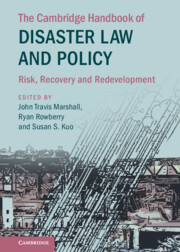Book contents
- The Cambridge Handbook of Disaster Law and Policy
- The Cambridge Handbook of Disaster Law and Policy
- Copyright page
- Dedication
- Contents
- Figures
- Maps
- Tables
- Contributors
- Foreword: Current Trends in Disaster Law and Policy
- Acknowledgments
- Introduction
- Part I Critical Perspectives on the Evolution of Disaster Law and Policy
- Part II Effective Governance as an Imperative for Responsive Disaster Law and Policy
- Part III Law’s Role in Promoting Hazard Mitigation: Intergovernmental, International, National, and Local Approaches
- Part IV Private Sector Initiatives to Promote Disaster Resilience and Recovery
- Part V Lawyers As Disaster Law and Policy Leaders: Training for Students and Guidance for Practitioners
- Part VI Cultural Heritage Protection and Cross-Disciplinary Opportunities for Advancing Disaster Law and Policy
- 26 Scheduled Monuments and Sites at Risk of Coastal Erosion: Danish Heritage Legislation and Actions
- 27 Heritage-Related Disaster Policy in the United States
- 28 Love for Heritage in the Time of Covid-19: Pandemics and Preparedness
- 29 Reflections on Urban Cultural Heritage, Public Health, and Public Participation
- Part VII Disasters and Vulnerable Communities
27 - Heritage-Related Disaster Policy in the United States
from Part VI - Cultural Heritage Protection and Cross-Disciplinary Opportunities for Advancing Disaster Law and Policy
Published online by Cambridge University Press: 27 October 2022
- The Cambridge Handbook of Disaster Law and Policy
- The Cambridge Handbook of Disaster Law and Policy
- Copyright page
- Dedication
- Contents
- Figures
- Maps
- Tables
- Contributors
- Foreword: Current Trends in Disaster Law and Policy
- Acknowledgments
- Introduction
- Part I Critical Perspectives on the Evolution of Disaster Law and Policy
- Part II Effective Governance as an Imperative for Responsive Disaster Law and Policy
- Part III Law’s Role in Promoting Hazard Mitigation: Intergovernmental, International, National, and Local Approaches
- Part IV Private Sector Initiatives to Promote Disaster Resilience and Recovery
- Part V Lawyers As Disaster Law and Policy Leaders: Training for Students and Guidance for Practitioners
- Part VI Cultural Heritage Protection and Cross-Disciplinary Opportunities for Advancing Disaster Law and Policy
- 26 Scheduled Monuments and Sites at Risk of Coastal Erosion: Danish Heritage Legislation and Actions
- 27 Heritage-Related Disaster Policy in the United States
- 28 Love for Heritage in the Time of Covid-19: Pandemics and Preparedness
- 29 Reflections on Urban Cultural Heritage, Public Health, and Public Participation
- Part VII Disasters and Vulnerable Communities
Summary
Historic places are vulnerable to a wide variety of threats: neglect, lack of maintenance, demolition, war, and, of course, time itself. No physical or legal intervention will ever be able to make them last forever. Yet, laws can help make historic sites more resilient to the avoidable consequences of obvious threats. This chapter focuses on the legal framework in the United States for fortifying heritage against one particular threat: disasters resulting from natural hazards. Natural hazards include large-scale meteorological and geological events such as hurricanes, tropical storms, tornadoes, floods, blizzards, wildfires, earthquakes, extreme heat, and drought. Climate change has made many of these events more frequent and more intense. Given the increasing risks to historic sites, one might think that planning, mitigation, and recovery efforts are being undertaken with increased urgency. Unfortunately, this is not the case. Without adequate planning and protection, some of our cultural heritage has already been lost or will be lost imminently. This chapter begins by identifying and assessing current policies regarding the protection of historic resources before, during, and after a disaster. It highlights key elements for successful legal protection at each of these three stages. Then it describes our multi-governmental, federalist framework for heritage-related disaster policy. This policymaking takes place at the federal, state, and local levels, mostly through the legislative process and action by executive agencies. Each level of government plays overlapping roles in planning for, mitigating, and recovering from disaster. As the scale of government gets smaller, coordination among historic preservation authorities becomes either less effective or non-existent. This chapter covers each level of government in turn by first describing federal disaster planning and historic preservation requirements. Next, the chapter explores how two states and four local governments have integrated disaster mitigation and historic preservation considerations.
- Type
- Chapter
- Information
- The Cambridge Handbook of Disaster Law and PolicyRisk, Recovery, and Redevelopment, pp. 436 - 450Publisher: Cambridge University PressPrint publication year: 2022



